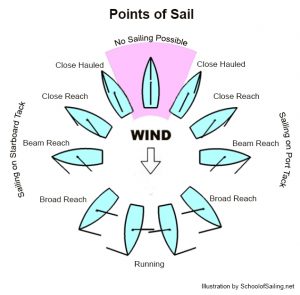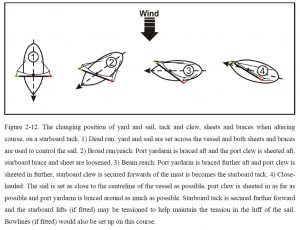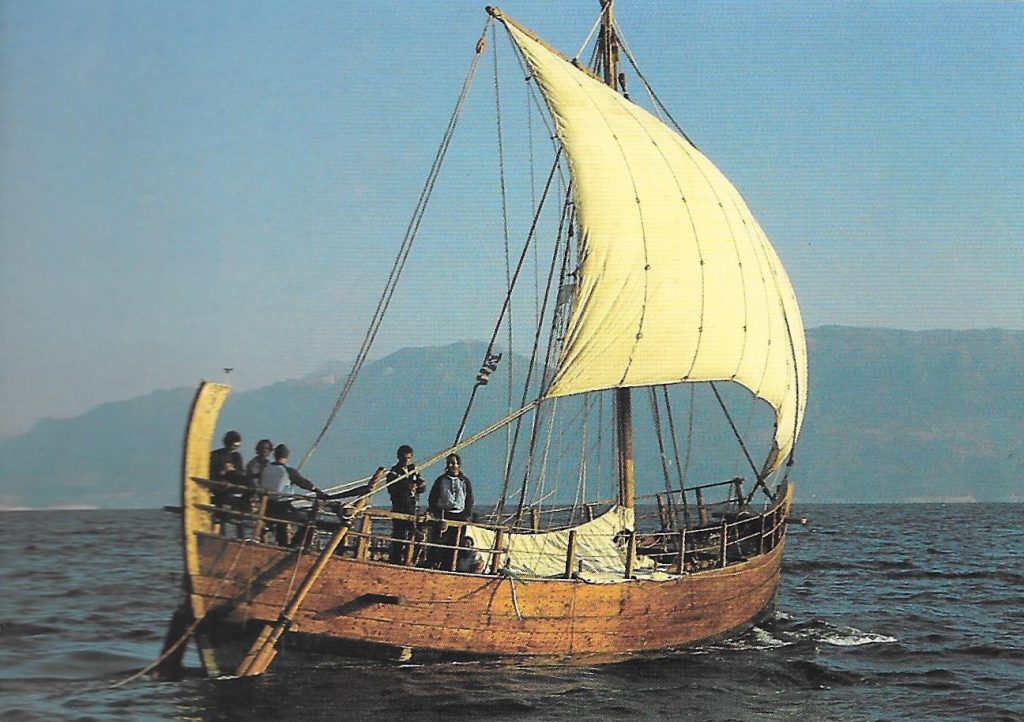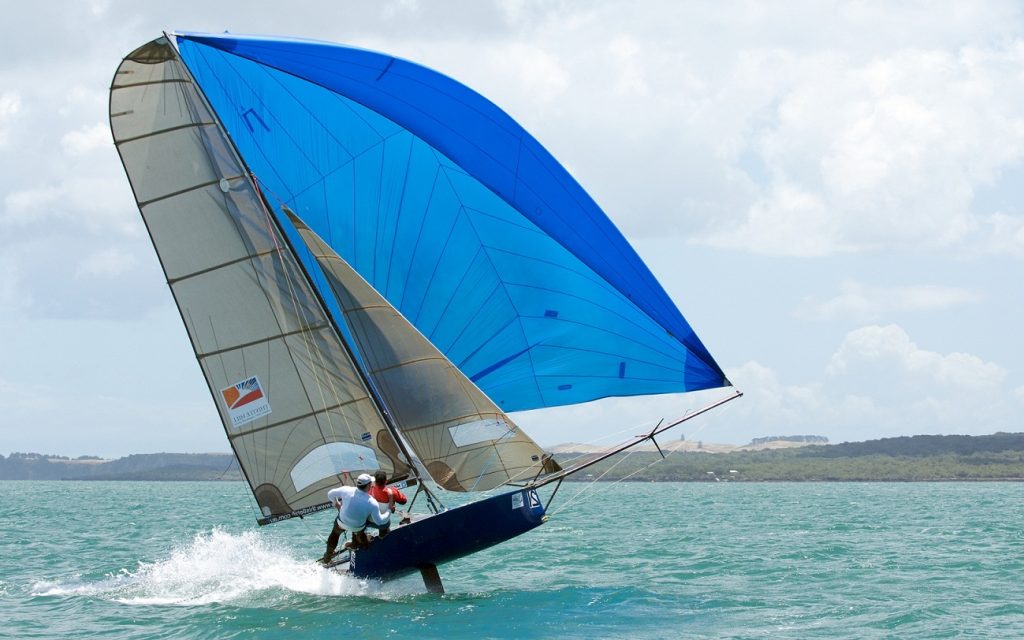Let’s have a look at wind forces and directions and how to use them for sailing a ship.
Wind force. Sailing was (and still is) considered comfortable with winds of Beaufort force 3-4 (up to 15 knots), it becomes quite ‘sportive’ with force 5-6 Bft and critical above force 7 Bft (over 30 knots). According to Pascal Arnaud (2005, p 22)[1], as long as a sea state (wind and waves) does not exceed say force 4 Bft (15 knots wind), the sailor is free to manoeuvre his ship in various directions, but for higher sea states he loses this freedom and has to sail downwind[2]. As, during storms, waves may be travelling at 10 to 20 knots, they can overtake the ship and thus require a high stern to avoid flooding the aft deck.
The 1986 Kyrenia II experiment (small 30-ton freighter of 14.5 x 4.5 m) has shown that an ancient merchant ship could resist well in a force 9-10 Bft storm (45-50 knots wind). Surely much better than any ancient battleship that would probably not resist more than force 6 Bft (25 knots wind) and 1 m waves, as shown during the Olympias sea trials (50-ton trireme of 37 x 5.5 m) in 1992 (Morrison et al., 2000). A similar experience was performed in 2017-2019 with the Ma’agan Mikhael II (small 20-ton freighter of 16.6 x 4.3 m) showing results similar to those obtained with the Kyrenia II (Palzur, 2021[3]).
Wind direction. It was mentioned above that, provided the wind force does not exceed 15 knots, the sailor has some freedom as to his direction of sailing. Ships were normally sailing from wind astern (180°) to wind abeam (90°), but it was possible to sail into the wind up to around 60° (see Arnaud, 2005[1], and Morrison et al., 2000[2]). However, such a close-hauled course was very uncomfortable and not very efficient because of the leeway (lateral drift) ranging between 10° and 20°: with a mild wind of 5 to 10 knots, the course with respect to the (“true”) wind direction was therefore around 70° to 80° (60° + 10° to 20° leeway), meaning that only 20° to 10° headway was really made with respect to the ‘no headway’ direction of 90°. This close-hauled sailing meant a lot of effort for small progress in the desired direction (of 0°) and both Casson (1995) and Whitewright (2011) concluded that the average speed in the desired direction was less than 2 to 2.5 knots. It may therefore be expected that few sailors would choose close-hauled sailing on a long distance, unless they were forced to do so by unexpected wind conditions or other compelling reasons[4].
The points of sail shown above are valid for modern ‘Bermuda’ rigs with a large genoa sail, but ancient ships had square sail(s) or a lateen or settee sail. Modern sailing boats may reach 20-30° as shown above, but they are designed for racing more than for transporting cargo.
If the ship’s destination requires sailing upwind, ‘beating to windward’, then periodic ‘changing tack’ is needed. It consists in zig-zaging on close-hauled courses. The ship’s speed in the desired direction (Vmg, ‘Velocity made good’[5]) is obviously reduced.
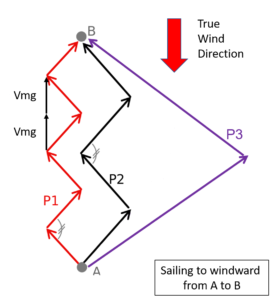
Close-hauled sailing course: P1 requires more turns, thus more time, but the total distance is the same as P2.
Close-reach sailing course: P3 requires more distance, but this may be faster as the speed is higher.
With a square sail or a lateen sail including a top yard, the preferred method for changing tack was by ‘wearing‘ : turn the ship to running downwind, then turn her back to a close-hauled course on the other tack (the word ‘gybing’ is used on modern yachts with triangular ‘fore-and-aft- rig’).
A merchant sailing ship will show the best performance when sailing at broad reach, but it also needs to show acceptable performance in sailing to windward at close reach with a simple easy-to-build sailing rig[6].
Notes
[1] ARNAUD, P., 2005, “Les routes de la navigation antique”, éd. Errance.
and:
ARNAUD, P., 2014, “Marseille grecque et les routes du commerce maritime”, in “Les territoires de Marseille antique”, Arles, Paris, éd. Errance, p 185-213.
and:
TAMMUZ, O., 2005, “Mare clausum? Sailing Seasons in the Mediterranean in Early Antiquity”, Mediterranean Historical Review, Vol 20, No. 2, December 2005, pp. 145-162.
[2] VIRGIL (Eneid, 5, 8-25) explains what any sailor would still do today with unfavourable winds, i.e. try tacking, but bear away to downwind if the wind is too strong.
[3] MORRISON, J.S.; COATES, J.F.; RANKOV, N.B., 2000, “The Athenian Trireme”, Cambridge University Press, (350 p).
PALZUR, Y. & CVIKEL, D., “Sailing Ma‘agan Mikhael II”, Archaeonautica [Online], 21 | 2021, (p 277-282).
See also: http://kyrenia-collection.org/styled-4/styled-7/index.html
[4] WHITEWRIGHT, J., 2011, “The Potential Performance of Ancient Mediterranean Sailing Rigs”, IJNA International Journal of Nautical Archaeology (2011), 40.1: 2–17.
See also his 2008 PhD thesis (Vol. I & Vol. II) at Southampton University.
GAL, D., SAARONI, H., CVIKEL, D., 2023, “Windward Sailing in Antiquity: The Elephant in the Room”, IJNA International Journal of Nautical Archaeology, DOI: 10.1080/10572414.2023.2186688
PALMER, C., 2009, “Windward Sailing Capabilities of Ancient Vessels”, IJNA International Journal of Nautical Archaeology, 38:2, (p 314-330), DOI: 10.1111/j.1095-9270.2008.00208.x .
CASSON, L., 1995, “Ships and seamanship in the ancient world”, Johns Hopkins University Press, (470 p).
Achilles TATIUS (Leucippe and Clitophon, 3, 1) describes windward sailing with multiple tacking.
[5] https://en.wikipedia.org/wiki/Velocity_made_good : rectilinear speed resulting from the much longer distance sailed while tacking.
[6] https://en.wikipedia.org/wiki/Category:Sailing_rigs_and_rigging.
